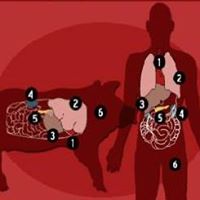From pig to human.
Transplants and implants of organs, glands, tissues, and cells, from pigs to people.
In the closing years of the 21st century, the demand
for transplants and implants grew to exceed the supply of human organs. This
fact led the scientific community to look for alternatives such as
xenotransplantation (transplantation between different species) with species
such as the pig since this animal has a series of characteristics: similarity
of the porcine genome with the human genome, and physiology of some of its organs
with those of humans.
The pig has turned out to be a good option for
transplants of skin, pancreas, heart valves, pituitary gland, etc.
The pig is a source of medicine.
The pig is also being used to produce some medicines,
such as:
. Insulin: The pig's pancreas is an organ from which
insulin is obtained, an essential hormone for diabetics.
. ACTH: From the pituitary or pituitary gland of the
pig ACTH can be obtained, a hormone used in human medicine for treating arthritis, cretinism, and inflammatory diseases.
. Thyroiodin: pig thyroids are also used to obtain
medications that stimulate the production of this hormone.
. Heparin;
from the intestinal mucosa of the pig, heparin is obtained, which has anticoagulant properties and is applied in human medicine in cases of thrombosis.
. Hemoglobin: Pigs can produce human hemoglobin, a
blood pigment that carries oxygen to the cells of the body.
.
Surfactant: It can be removed from the lung of the pig. This substance is
essential for the treatment of babies born with pulmonary immaturity.
The piglet pituitary implant has been applied in
patients with menopause, sexual dysfunction, senile dementia, type I and II
diabetes mellitus, diabetic retinopathy, and developmental deficiencies, to retard the processes that
lead to aging and chronic and degenerative diseases.
Do you
Good Health to All!!!
More information about sucker pig pituitary implants:
Cell 52 322 888 7134
Email:
jesus17021959@gmail.com
Puerto
Vallarta, Jalisco, Mexico.







Comments
Post a Comment